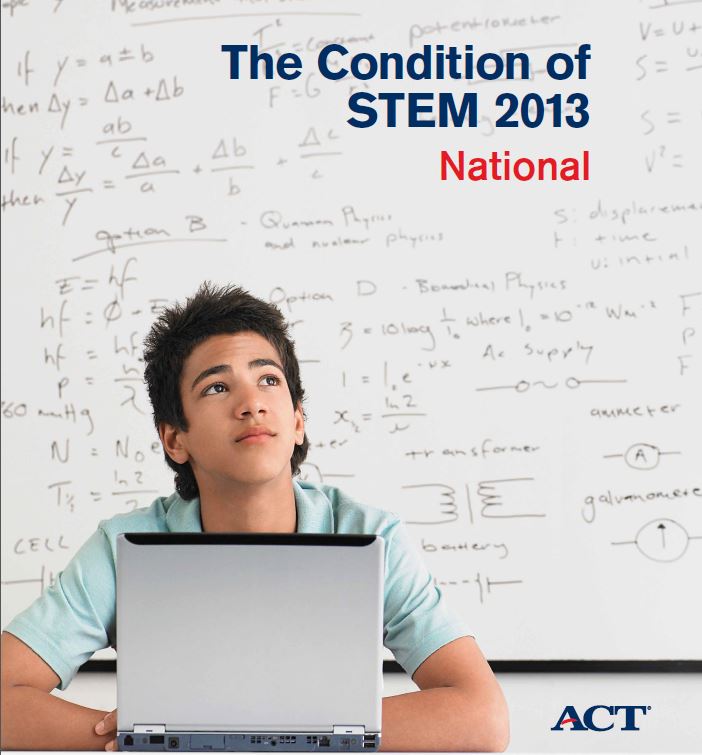
A new report from ACT reveals an untapped pool of students who have an interest in STEM areas (science, technology, engineering, and mathematics) but are not planning to pursue a STEM career as they prepare for the future. The data point to a gap between interests and intentions that, if addressed, could help put more students on the path to STEM careers.
"The good news is that student interest in STEM is high overall," said Jon Erickson, ACT president of education and career solutions. "The bad news is that a sizable number of students may not be connecting the dots between their innate interests and a potential STEM-related career."
The ACT national and state report series, The Condition of STEM 2013, examines the expressed and measured interests of high school graduates in the class of 2013 who took the ACT® college readiness exam. Expressed interest is when students say they intend to pursue a particular major or occupation. Measured interest, in contrast, is derived from students' responses to the ACT Interest Inventory, a battery of questions that measures preferences for different types of work tasks.
A total of 48 percent of the ACT-tested 2013 graduates had expressed and/or measured interest in STEM, including 16 percent who had both. Twenty-three percent had only expressed interest, planning to pursue a STEM career even though their inventory results suggest that other fields may be better aligned to their interests. But nearly one out of every 10 graduates (9 percent) had only measured interest in STEM; they had no plans to pursue a STEM major or career despite their innate interest.
"Nothing is more costly to the nation than untapped potential, and that's why we must do more to ensure that all students understand the career opportunities that match their interests, particularly those that exist in important STEM fields," said Erickson. "If we can identify students earlier and then keep them engaged, they may be more likely to choose a STEM career."
ACT's report also points to a gap between STEM interest and preparation. Around half or more of the 2013 ACT-tested graduates planning to pursue STEM majors and careers were not ready to succeed in first-year math or science coursework in college. Readiness was significantly higher, however, among students with both expressed and measured interest than among those with only expressed interest.
"Early assessment and intervention are extremely important in helping students get on track for college and career success, and that's particularly true in the areas of math and science, where so many of our students are falling behind," said Erickson. "That's one reason why we’ve built STEM scores and benchmarks into our new ACT Aspire™ system and why we're committed to keeping science tests in the ACT and ACT Aspire assessments."
Selecting a career that matches interests can help students succeed. Previous ACT research has shown that when students' interests are aligned with their chosen college majors, they are more likely to remain in their major, persist in college and complete their degree in a timely manner.
"The findings in this new report are supported by those in our recent College Choice Report, which showed that a surprising number of students are planning to pursue majors or careers that don’t match their interests," said Wayne Camara, ACT senior vice president of research. "If we encourage young students who are interested in STEM to consider related careers, I believe both they and U.S. employers will benefit."
A number of national reports have pointed to a need for more workers in STEM fields. A recent report from the Bayer Corporation’s Facts of Science Education survey suggests Fortune 1000 companies are struggling to fill STEM positions due to a shortage of qualified candidates. And a 2012 report by President Obama’s Council of Advisors on Science and Technology concluded that the need for STEM professionals will significantly outweigh the availability of those workers over the next decade if current trends continue.
"This report gives educators, business leaders and policymakers access to important new information regarding the condition of STEM education in our country," said Lisa Brady Gill, executive director of education policy and advocacy for Texas Instruments. "We feel it provides much-needed insight that will help us as we work together toward real and meaningful change in this area."
The STEM job outlook is strong, and STEM occupations tend to be high paying, according to the U.S. Department of Labor’s Bureau of Labor Statistics. In the recently released U.S. News & World Report 100 Best Jobs of 2014, more than half of the top 50 jobs are STEM related.
The Condition of STEM 2013 reports for the nation and for each state can be accessed on ACT’s website at http://www.act.org/stemcondition.